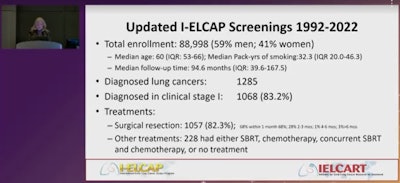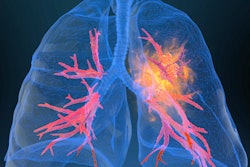
New results from the international, multicenter study of CT screening for lung cancer (I-ELCAP) show that, despite criticism of initial findings, 10-year survival rates for lung cancer of 80% have persisted and that 20-year lung cancer-specific survival rate is 80.5%, delegates heard on 27 November at RSNA in Chicago.
Presenting the 20-year I-ELCAP figures, Dr. Claudia Henschke from the Icahn school of medicine, Mount Sinai, and Phoenix Veterans Health Care System noted that the results confirmed the study's
previous estimates of participants' lung cancer survival rates and adds further evidence of the high curability of lung cancer diagnosed by low-dose CT (LDCT) screening.
The results also show that lung cancer consistency is an important predictor of lung cancer survival and should be considered in updated staging criteria as has already been accepted in the pathologic criteria, she noted.
"People being screened ask how often is lung cancer detected and if detected how often it can be cured, but determining cure rates for lung cancer is more complicated than determining them for an infectious disease," Henschke told delegates. "This study I hope illustrates the power of prospective data collection in the context of clinical care as recommended by the Institute of Medicine long ago."
 Looking to the future: Bloodmarkers may replace LDCT for early cancer detection in the future. Image courtesy of Dr. Claudia Henschke.
Looking to the future: Bloodmarkers may replace LDCT for early cancer detection in the future. Image courtesy of Dr. Claudia Henschke.On behalf of the I-ELCAP investigators, Henschke's group aimed to estimate 20-year Kaplan-Meier lung cancer-specific survival (LCS), regardless of treatment, of 87,416 participants enrolled in the prospective, international, multicenter study for early detection of lung cancer both overall and with particular attention to cancers manifesting on CT images as solid, part-solid and nonsolid consistency. The group also estimated LCS for clinical stage IA and for resected pathologic stage IA cancers of 10 mm or less on the same CT image. Participants, enrolled between 1992 and 31 December 2021 are 40 years of age and older, and are current, former, or never smokers.
For all 1,285 I-ELCAP participants diagnosed with lung cancer, LCS was 80% (95% confidence interval [CI], 77-83). Strikingly, no cancer deaths were identified in part solid and nonsolid cancers (294 cancers). LCS was 100% for 139 participants with nonsolid and 155 participants with part-solid consistency. Meanwhile, for 991 solid consistency cancers, LCS was somewhat lower at 73% (95% CI, 69-77). LCS for clinical Stage IA participants was 86% (95% CI, 83-89), regardless of consistency. For participants with pathologic Stage IA lung cancers of 10 mm or less in average diameter, the 20-year LCS was 92% (95% CI, 87-96).
There have been many criticisms of the study since it first started publishing results, Henschke told delegates, pointing to the study's 2006-published 10-year survival rate of 80% (95% CI, 74-85) for 484 participants with first primary diagnoses of lung cancer either screen- or interim diagnosed.
"Such criticisms suggested curability results were overestimated due to lead time, length bias and overdiagnosis bias, and that all of those biases could explain part or all of the positive effect that we showed," Henschke said. "However, the updated ELCAP survival rate 1992 to 2022 showed 1068 (83.2%) cancers of 1,285 cancers diagnosed at stage 1, and the 20-year overall lung cancer survival rate is 80.5%."
The 20 year lung cancer-specific survival rates for all I-ELCAP participants reflects the high cure rate of early screen-detected lung cancers, she noted.
"To maximize the benefit of screening we really need to keep rethinking and optimizing all components of the diagnostic-treatment paradigm, and in the future perhaps blood markers will allow us to detect it in the first half of the life cycle of the lung cancer, instead of with CT at the beginning of the second half of its life cycle," she said.




















